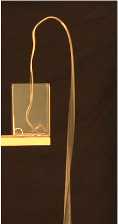2022 Problems
The 2022 tournament was held at The Science House at North Carolina State University (Raleigh, NC) on Saturday and Sunday, February 5-6, 2022. The USIYPT 2022 Champion is the Nueva School, with second place going to Cary Academy. The Swartz Trophy goes to Phillips Andover Academy. This year was unique in that all teams could not be present because of the lingering pandemic, so those not in attendamce were able to send in a poster; The Harker School was declared the poster session champion.
Rope and Chain Fountains
The figure shows a long chain falling from a jar, which, oddly, rises well above the jar’s walls as it falls to the ground. Why would the chain rise up like this without any interaction with the walls or anything above the jar to lift it up? It appears to defy gravity.
Investigate, both experimentally and theoretically, the physics of rope and chain fountains.
 The figure is from: J. Pantaleone, “A quantitative analysis of the chain fountain,” American Journal of Physics 85, 414 (2017).
The figure is from: J. Pantaleone, “A quantitative analysis of the chain fountain,” American Journal of Physics 85, 414 (2017).
A Magnetic Force Law One of our first experiences with permanent magnets is that like poles repel and opposite poles attract. Charles-Augustin de Coulomb tried in vain to develop a simple magnetic force law, much like his electrostatic law, but these attempts ultimately failed since there is no magnetic corollary to charge. That said, for the simple case of spherical magnets one would expect a simple attractive force law. For this problem you are to measure the attractive force between strong spherical magnets, which are free to rotate, as a function of the distance between their centers. Compare your measurements to the force predicted by classical electrodynamics as we now understand it.
Turbulence in a French Press A French press coffee maker is simply a glass beaker with a mesh piston to filter out the coffee grounds after mixing with the water. Take a French press, fill it about ¾ of the way with boiling water, and then float coffee grounds, or tea leaves, on top of the water. Slowly push the plunger down a short distance, and pull it back quickly. Do the same thing again, but pull it back slowly; repeat it again without pulling it back at all. Investigate, both experimentally and theoretically, the onset of turbulence and the mixing of fluids, using French press coffee pots.
The Longitude Problem Ever since Eratosthenes measured the size of the Earth in the third century BC, measuring one’s north-south location on the high seas has been easy. However, finding one’s east-west location remained an intractable problem for the next two millennia until John Harrison invented the marine chronometer in 1761 AD. The problem is that while one can measure the local time astronomically, one must also know the corresponding time at a known longitude, which was a difficult problem on land and impossible on a rocking boat at sea. Measure the latitude and longitude of your land-based observatory, using no technology invented after 1760 AD